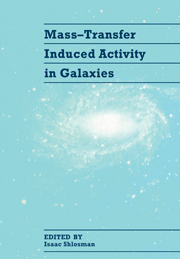Book contents
- Frontmatter
- Contents
- Preface
- List of Participants
- I INTRODUCTION
- II THE INNER PARSEC
- III THE CIRCUMNUCLEAR REGION
- IV GAS DYNAMICS AND STAR FORMATION IN BARRED AND NORMAL GALAXIES
- Star Formation in Barred Galaxies (Invited paper)
- Gas Dynamics and Star Formation in and Around Bars (Invited paper)
- Nuclear Starbursts in Barred Spiral Galaxies
- Molecular Inflows towards Galactic Nuclei
- Bar-Driven and Interaction-Driven Starbursts in SO/Sa Galaxies
- Gas Inflow due to Perpendicular Orbits in Barred Potentials
- Neutral Gas in the Barred Starburst Galaxy Maffei 2 (Poster paper)
- The Abundance Gradients in Barred Galaxies: the Role of Radial Flows (Poster paper)
- Bar Induced Non–Circular Molecular Gas Motions in M82 (Poster paper)
- Star Complexes and Evolution of Disk Galaxies (Poster paper)
- Interstellar Gas Flows in the Gravitational Potential Well of Density Waves (Poster paper)
- Massive Gas Rings in the Nuclei of Barred Spiral Galaxies (Poster paper)
- Pattern Speeds and Time Evolution in Ringed Galaxies from Observational and Simulational Databases (Poster paper)
- Large Scale Gravitational Instability and Galactic Viscosity (Poster paper)
- V NUCLEAR GAS AND LARGE-SCALE PROPERTIES OF AGN AND STARBURST HOSTS
- VI HOST GALAXY-AGN-NUCLEAR STARBURST CONNECTION
- VII GALAXY INTERACTIONS AND INDUCED ACTIVITY
- VIII GAS DYNAMICS IN ELLIPTICALS
- IX AGN AND STARBURST HOSTS AT LARGE REDSHIFTS
- X CONFERENCE SUMMARY
- Subject Index
- Object Index
- Author Index
The Abundance Gradients in Barred Galaxies: the Role of Radial Flows (Poster paper)
Published online by Cambridge University Press: 05 May 2010
- Frontmatter
- Contents
- Preface
- List of Participants
- I INTRODUCTION
- II THE INNER PARSEC
- III THE CIRCUMNUCLEAR REGION
- IV GAS DYNAMICS AND STAR FORMATION IN BARRED AND NORMAL GALAXIES
- Star Formation in Barred Galaxies (Invited paper)
- Gas Dynamics and Star Formation in and Around Bars (Invited paper)
- Nuclear Starbursts in Barred Spiral Galaxies
- Molecular Inflows towards Galactic Nuclei
- Bar-Driven and Interaction-Driven Starbursts in SO/Sa Galaxies
- Gas Inflow due to Perpendicular Orbits in Barred Potentials
- Neutral Gas in the Barred Starburst Galaxy Maffei 2 (Poster paper)
- The Abundance Gradients in Barred Galaxies: the Role of Radial Flows (Poster paper)
- Bar Induced Non–Circular Molecular Gas Motions in M82 (Poster paper)
- Star Complexes and Evolution of Disk Galaxies (Poster paper)
- Interstellar Gas Flows in the Gravitational Potential Well of Density Waves (Poster paper)
- Massive Gas Rings in the Nuclei of Barred Spiral Galaxies (Poster paper)
- Pattern Speeds and Time Evolution in Ringed Galaxies from Observational and Simulational Databases (Poster paper)
- Large Scale Gravitational Instability and Galactic Viscosity (Poster paper)
- V NUCLEAR GAS AND LARGE-SCALE PROPERTIES OF AGN AND STARBURST HOSTS
- VI HOST GALAXY-AGN-NUCLEAR STARBURST CONNECTION
- VII GALAXY INTERACTIONS AND INDUCED ACTIVITY
- VIII GAS DYNAMICS IN ELLIPTICALS
- IX AGN AND STARBURST HOSTS AT LARGE REDSHIFTS
- X CONFERENCE SUMMARY
- Subject Index
- Object Index
- Author Index
Summary
ABSTRACT
We present a study of the O/H gradients derived from large numbers of HII regions in a sample of barred galaxies. It is shown that the slopes of the O/H gradients in galaxies with a barred structure are related to the bar strength: the stronger is the bar, the flatter the abundance gradient becomes. This result is in agreement with a scenario of mixing of the interstellar gas by radial flows across the disks of barred galaxies. Thus we concluded that a bar acts as a homogenizer on the chemical composition in a spiral galaxy.
INTRODUCTION: RADIAL FLOWS
Observations and numerical simulations have shown that strong radial flows are present in barred spiral galaxies (e.g. Sellwood and Wilkinson 1993). Although the exact origin of such flows is unclear, their amplitudes seem to be related to the bar properties and to the presence of radiative shocks induced when the gas passes through the bar. A possible important consequence of radial flows in a spiral galaxy is a radial redistribution of the chemical composition across the disk. Such mechanism was suggested to explain why the O/H gradients in few barred galaxies (e.g. NGC 1365) are shallower than gradients observed in normal spirals.
Review works by Vila-Costas and Edmunds (1992, VE) and Zaritsky et al. (1993, ZKH) have confirmed this difference. However, their large samples of galaxies included very few barred spirals where the O/H gradient is derived from a large number of HII regions.
- Type
- Chapter
- Information
- Mass-Transfer Induced Activity in Galaxies , pp. 177 - 178Publisher: Cambridge University PressPrint publication year: 1994

